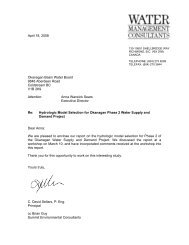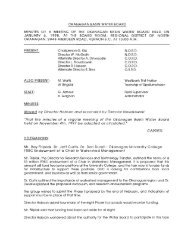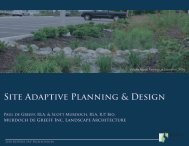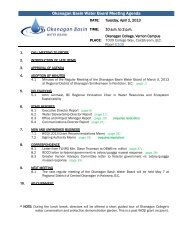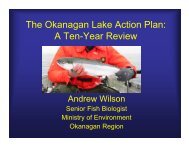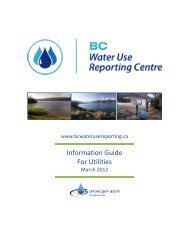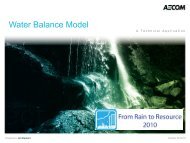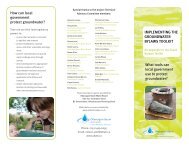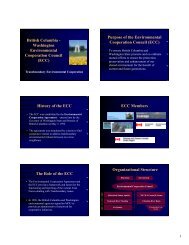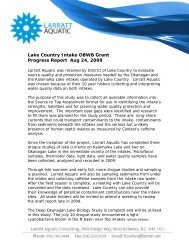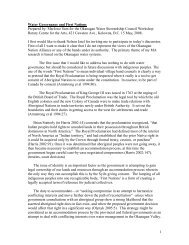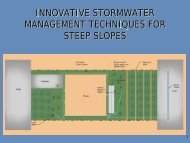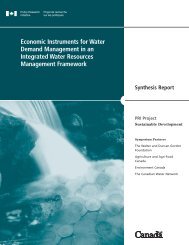Instream Flow Needs Analysis - Okanagan Basin Water Board
Instream Flow Needs Analysis - Okanagan Basin Water Board
Instream Flow Needs Analysis - Okanagan Basin Water Board
- No tags were found...
Create successful ePaper yourself
Turn your PDF publications into a flip-book with our unique Google optimized e-Paper software.
FINAL<strong>Okanagan</strong> <strong>Basin</strong> <strong>Instream</strong> <strong>Flow</strong> <strong>Needs</strong>In this study we used the <strong>Water</strong> Supply & Demand Study Working Group 11-year standard period (1996to 2006) of evaluation. However, some of the calculations used in our analysis consider a longer timeseries to avoid time trend bias (i.e., see MAD correction described in section 2.4.4) and to reflect thelonger-term evolutionary adaptations of our focal fish species. Additionally, it should be noted that as thecalculated IFN values represent single averages determined across the 11 years of “naturalized flow” datathe weekly IFN values uploaded to the Ok<strong>Water</strong>DB are repeated for each year of the 1996–2006 period(i.e., default weekly IFN values that are the same in each year). As such, cross-year statistical analysesshould not be performed with the IFN values that have been uploaded to the Ok<strong>Water</strong>DB.1.2.1 Project oversightThe <strong>Okanagan</strong> <strong>Basin</strong> <strong>Water</strong> <strong>Board</strong> (OBWB), along with provincial and federal agencies and First Nationsare completing Phase 2 of the <strong>Okanagan</strong> <strong>Water</strong> Supply and Demand Project. The goals for Phase 2include determination of the current supply of and demand for water throughout the <strong>Okanagan</strong> <strong>Basin</strong>;development of a model (or linked suite of models) that routes water from tributaries into main valleylakes and downstream into Osoyoos Lake that can be used to examine water management alternatives,and identification of potential future changes in both water supply and demand. A Steering Committeewith representation from the major project funders and other agencies provided guidance and leadershipto the Phase 2 study. A Working Group composed of about 20 individuals from various agencies andstakeholders is responsible for project implementation. This group provided the technical expertise andlocal knowledge to drive the project. A Project Manager was responsible for overseeing the completion ofthe Phase 2 work. The Phase 2 project prospectus is available on the OBWB website at:www.obwb.ca/fileadmin/docs/Supply_Demand_Phase_2_Prospectus.pdf.Within the overall team structure for the <strong>Okanagan</strong> <strong>Water</strong> Supply Project) are a series of TechnicalCommittees tasked with completing specific analyses required within the project (see Figure 1.2). Theseconsist of technical committees for the Hydrologic and <strong>Water</strong> Balance Model, <strong>Water</strong> Use, LakeEvaporation, Groundwater, and <strong>Instream</strong> <strong>Flow</strong>. The <strong>Instream</strong> <strong>Flow</strong> <strong>Needs</strong> Technical Committee thatprovided oversight for the work undertaken in this report consisted of Kim Hyatt (Chair, DFO), Phil Epp(MOE), Howie Wright (ONA) and Brian Guy (Summit Environmental Ltd.).5 ESSA Technologies Ltd. &Solander Ecological Research



